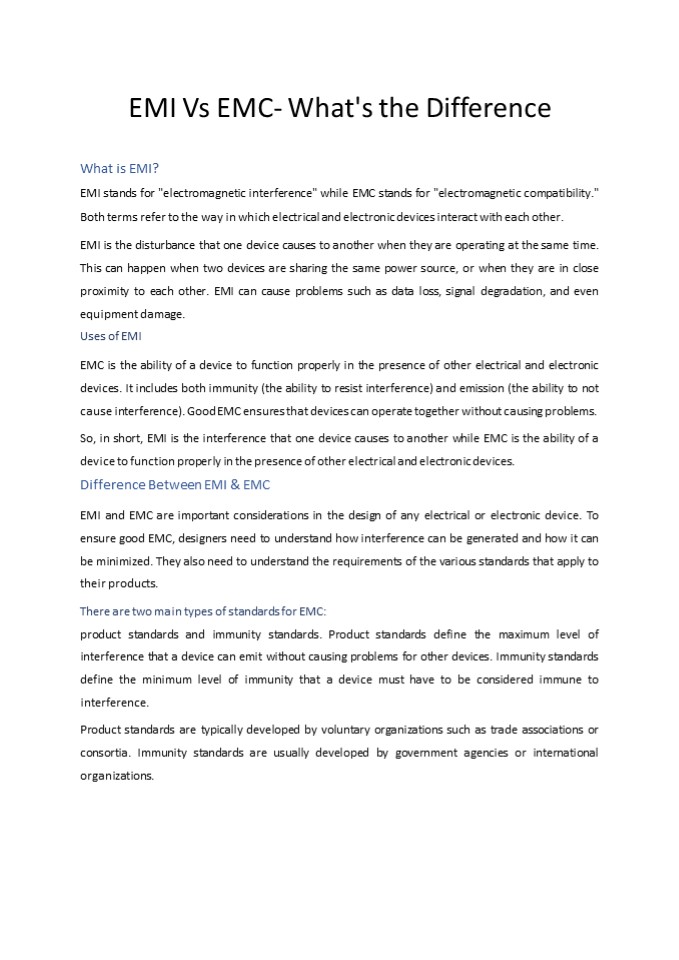EMI/EMC Testing Difference - PowerPoint PPT Presentation
Title:
EMI/EMC Testing Difference
Description:
The difference between EMC and EMI testing is that the former tests for immunity to electrical disturbances, while the latter determines whether or not a device will emit electromagnetic radiation. – PowerPoint PPT presentation
Number of Views:13
Title: EMI/EMC Testing Difference
1
EMI Vs EMC- What's the Difference
What is EMI? EMI stands for "electromagnetic
interference" while EMC stands for
"electromagnetic compatibility." Both terms refer
to the way in which electrical and electronic
devices interact with each other. EMI is the
disturbance that one device causes to another
when they are operating at the same time. This
can happen when two devices are sharing the same
power source, or when they are in close proximity
to each other. EMI can cause problems such as
data loss, signal degradation, and even equipment
damage. Uses of EMI EMC is the ability of a
device to function properly in the presence of
other electrical and electronic devices. It
includes both immunity (the ability to resist
interference) and emission (the ability to not
cause interference). Good EMC ensures that
devices can operate together without causing
problems. So, in short, EMI is the interference
that one device causes to another while EMC is
the ability of a device to function properly in
the presence of other electrical and electronic
devices. Difference Between EMI EMC EMI and EMC
are important considerations in the design of any
electrical or electronic device. To ensure good
EMC, designers need to understand how
interference can be generated and how it can be
minimized. They also need to understand the
requirements of the various standards that apply
to their products. There are two main types of
standards for EMC product standards and immunity
standards. Product standards define the maximum
level of interference that a device can emit
without causing problems for other devices.
Immunity standards define the minimum level of
immunity that a device must have to be considered
immune to interference. Product standards are
typically developed by voluntary organizations
such as trade associations or consortia. Immunity
standards are usually developed by government
agencies or international organizations.
2
Product standards typically apply to specific
types of devices, such as computers, televisions,
and radios. Immunity standards usually apply to
specific environments, such as industrial sites
or military bases. There are a number of
different EMC standards that have been developed
over the years. The most important ones are
listed below FCC Part 15 This standard
covers intentional and unintentional radiators.
Intentional radiators are devices that
deliberately generate electromagnetic energy,
such as radio transmitters. Unintentional
radiators are devices that generate
electromagnetic energy as a by-product of their
normal operation, such as computers and electric
motors. FCC Part 18 This standard covers
the immunity of industrial, scientific, and
medical (ISM) equipment. ISM equipment is
designed to be used in environments where there
is a potential for interference, such as
factories and hospitals. MIL-STD 461 This
standard covers the immunity of military
equipment. It includes requirements for both
conducted and radiated emissions. EN 55022
This European standard covers the emission limits
for information technology equipment. EN
61000-3-2 This European standard covers the
immunity requirements for household
appliances. EMI/EMC testing are important
considerations in the design of any electrical or
electronic device. To ensure good EMC, designers
need to understand how interference can be
generated and how it can be minimized. They also
need to understand the requirements of the
various standards that apply to their products.































